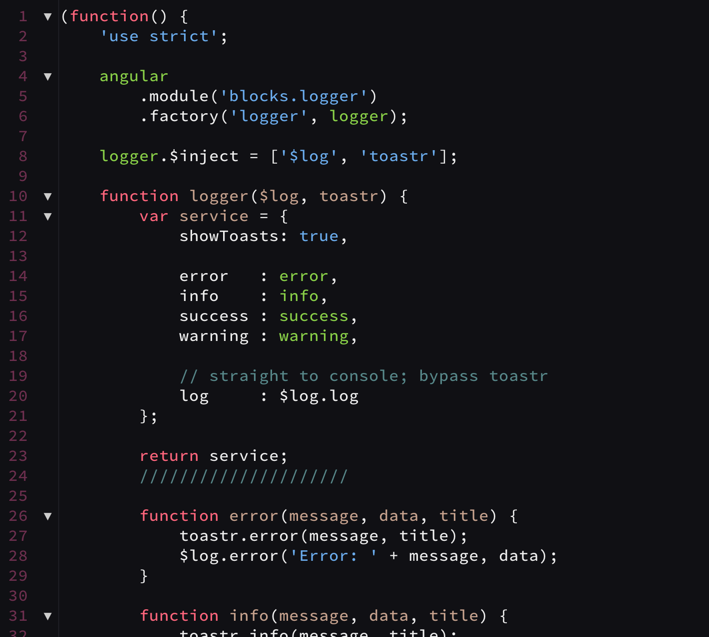Factories are singletons and return an object that contains the members of the service.
Expose the callable members of the service (its interface) at the top, using a technique derived from the Revealing Module Pattern.
Why?: Placing the callable members at the top makes it easy to read and helps you instantly identify which members of the service can be called and must be unit tested (and/or mocked).
Why?: This is especially helpful when the file gets longer as it helps avoid the need to scroll to see what is exposed.
Why?: Setting functions as you go can be easy, but when those functions are more than 1 line of code they can reduce the readability and cause more scrolling. Defining the callable interface via the returned service moves the implementation details down, keeps the callable interface up top, and makes it easier to read.
/* avoid */
function dataService() {
var someValue = '';
function save() {
/* */
};
function validate() {
/* */
};
return {
save: save,
someValue: someValue,
validate: validate
};
}
/* recommended */
function dataService() {
var someValue = '';
var service = {
save: save,
someValue: someValue,
validate: validate
};
return service;
////////////
function save() {
/* */
};
function validate() {
/* */
};
}
This way bindings are mirrored across the host object, primitive values cannot update alone using the revealing module pattern.

Use function declarations to hide implementation details. Keep your accessible members of the factory up top. Point those to function declarations that appears later in the file. For more details see this post.
Why?: Placing accessible members at the top makes it easy to read and helps you instantly identify which functions of the factory you can access externally.
Why?: Placing the implementation details of a function later in the file moves that complexity out of view so you can see the important stuff up top.
Why?: Function declarations are hoisted so there are no concerns over using a function before it is defined (as there would be with function expressions).
Why?: You never have to worry with function declarations that moving var a before var b will break your code because a depends on b.
Why?: Order is critical with function expressions
/**
* avoid
* Using function expressions
*/
function dataservice($http, $location, $q, exception, logger) {
var isPrimed = false;
var primePromise;
var getAvengers = function() {
// implementation details go here
};
var getAvengerCount = function() {
// implementation details go here
};
var getAvengersCast = function() {
// implementation details go here
};
var prime = function() {
// implementation details go here
};
var ready = function(nextPromises) {
// implementation details go here
};
var service = {
getAvengersCast: getAvengersCast,
getAvengerCount: getAvengerCount,
getAvengers: getAvengers,
ready: ready
};
return service;
}
/**
* recommended
* Using function declarations
* and accessible members up top.
*/
function dataservice($http, $location, $q, exception, logger) {
var isPrimed = false;
var primePromise;
var service = {
getAvengersCast: getAvengersCast,
getAvengerCount: getAvengerCount,
getAvengers: getAvengers,
ready: ready
};
return service;
////////////
function getAvengers() {
// implementation details go here
}
function getAvengerCount() {
// implementation details go here
}
function getAvengersCast() {
// implementation details go here
}
function prime() {
// implementation details go here
}
function ready(nextPromises) {
// implementation details go here
}
}